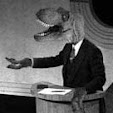So, why not start small?
The M-28/M-29 Recoilless Rifle loaded with the M-388 Davy Crockett

Featuring a 76 pound nuclear device (including 51 pound warhead) atop a recoilless rifle, the Davy Crockett was the smallest nuclear weapon deployed by the US. In service from 1961 to 1971, the weapon was provided to a number of units in Europe during the Cold War with the goal of warding off a potential Soviet offensive. With a variable yield between 10 tons and 250 tons, the damage output for a nuclear weapon may seem relatively small, but imagine the simultaneous detonation of 10 tons of TNT and we're on our way to a deadly bazooka equivalent.
The weapon had two potential recoilless rifle mounts (a recoilless gun allows the gases from the propellant to escape out the rear of the weapon and not out the barrel with the projectile, reducing recoil). A 120mm variant called the M28 and a 150mm variant called the M29, the difference being their 1.25 and 2.5 mile range, respectively (the US military does love the letter M). The US army also looked into a variety of other warheads and weapons platforms.
At such a small yield the danger from heat and flash are minimal; even electromagnetic problems would be trivial compared to the amount of radiation output. Unfortunately even at the standardized 20 ton yield the weapon would be relatively lethal up to 400m from the blast center. That's assuming there's no wind carrying all of the fallout into the firing team in the first place. The weapon's minimum range setting was 300m, and at a 20 ton yield that's a bit of a sick joke since all of the operators would get lethal doses of radiation at that distance. The rifles' purported ranges of 1.25 and 2.5 miles are a bit misleading as well; neither rifle was especially accurate in test firings. The weapon's maximum yield also effectively negates its firing range.


There's also the chance that one slip up could lead to this.
'Atomic Annie' (11 inch gun) firing the only test-fired W9 nuclear artillery shell

As part of the US Army's love for all things nuclear in the 1950s they started research into nuclear artillery. Two decades saw the creation of numerous artillery and warhead pairs, but the W9 is the only warhead to ever be successfully test-fired from an actual artillery piece (the W33 warhead was tested twice without being fired from a gun).
Part of the US military's first foray into nuclear artillery testing, the W9 shot pictured above was from the Grable shot in the Upshot-Knothole series of nuclear tests. I have no idea who names these things, but they are probably crazy. Operation Upshot-Knothole's objective was to investigate a variety of nuclear weapon designs and begin combat operations testing for the US military, including the proofing of tactical nuclear weapons.
The explosion was a 15 kiloton yield - viewable above at 6 miles away from the artillery piece. The small white lines (which pop up in many photos of nuclear weapon tests) are for blast wave analysis and aren't part of the explosion. The US deployed some form of nuclear artillery up until the denuclearization of the armed forces in 1992... Never mind that an assortment of nuclear test ban treaties prevented the military from actually testing the viability and functionality of those weapons.
The RDS-220 'Big Ivan', also known as the Tsar Bomba

The Tsar Bomba weapon series consisted of a single 50+ megaton nuclear weapon dropped on Novaya Zemlya archipelago on October 30th, 1961. Developed within a 16 week timeframe at the behest of Nikita Khrushchev, the bomb derived from a 100 megaton design far too heavy for deployment (the 50 Mt variant that was tested required a modified Tu-95N bomber to get it into the air). Only one functioning weapon was built, with a replica housed at the Russian Nuclear Weapons Museum in Sarov (the center of Soviet nuclear weapons design, near Novgorod - called Kremlyov until 1995).
The weapon's detonation ended a two year voluntary US/USSR nuclear testing cessation, and prompted the US to redouble its nuclear development program.
Dropped from a height of 4000m the explosion reached to the ground before convection currents lifted the fireball and mushroom cloud 64km into the atmosphere. The blast leveled the sole settlement 55km away and knocked over buildings and broke windows further than 100km away. The flash was visible more than 1000km away (where high-ranking Soviet observers ...observed). At 50 Mt the Tsar bomba is easily the largest built and detonated nuclear weapon.
At the very least, woo, nuclear fireworks for New Years.

2 comments:
I actually watched a documentary one night on discovery HD theatre about the history of atomic bombs in 42" of HD 7.1 surround sound magic.
I was erect for approx. 60 minutes of the 90 minute documentary.
Tsar Bomba was insane. They say the shockwave was measurable around the earth 4 times.
It'd be cool to check out some of the sites where all the nukes were tested during the cold war just to see what sort of animal and plant life is there now.
There was another documentary about this and Chernobyl I believe.
Although the US military has had many, many terrible ideas throughout history, puting a nuclear warhead on a rifle has to make the top five.
I hope to see more of the, "collection fo curiosities" series. If all goes well, I can see an History Channel documentary series.
Post a Comment